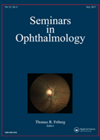You searched for "fluorescein"
How to survive the fluorescein round
1 December 2016
| Gwyn Samuel Williams
|
EYE - Cataract, EYE - Cornea, EYE - Glaucoma, EYE - Imaging, EYE - Neuro-ophthalmology, EYE - Oculoplastic, EYE - Oncology, EYE - Orbit, EYE - Pathology, EYE - Paediatrics, EYE - Refractive, EYE - Strabismus, EYE - Vitreo-Retinal, EYE - General
One of the highlights of the medical retina fellowship programme at Moorfields is the Tuesday morning 8am fluorescein round. It is both exhilarating and terrifying. Exhilarating because they are slick presentations of the most interesting cases that each of the...
Fluorescein angiography and OCT in myopic CNV
1 December 2014
| Bheemanagouda Patil
|
EYE - Vitreo-Retinal
Fluorescein angiography (FA) and spectral-domain optical coherence tomography (OCT) are the most common examinations used in the management of anti-VEGF therapy in choroidal neovascularisation (CNV). In comparison to FA, OCT provides a noninvasive evaluation of the macula. Myopic CNV are...
Use of oral fluorescein angiography in a paediatric population
The authors report a retrospective records review of all patients who received an oral ultrawide fluorescein angiography (FA) over a 42-month period at a single children’s hospital. Data were extracted from the records including indication for FA, adverse events, pauses...Reliability of Fluorescein Dye Disappearance Test (FDDT)
The authors look at the role of the FDDT in the evaluation of adults with primary acquired nasolacrimal duct obstruction (PANDO) and its correlation with the age and severity of epiphora. They report the results of a prospective cross-sectional comparative...Akimba mice, a model of human diabetic retinopathy
1 October 2014
| Graham Wallace
|
EYE - Vitreo-Retinal
Diabetic retinopathy (DR) is a major complication of diabetes and a growing problem as the systemic disease becomes more prevalent. DR develops insidiously from an asymptomatic form through to vascular damage that leads to oedema and breakdown of the blood-retinal...
Step-by-step guide to mastering skills with the Goldmann applanation tonometer
2 August 2024
| Joan Efua Hanson
|
EYE - Glaucoma
Ophthalmology is a highly specialised field that requires proficiency in various diagnostic skills for numerous conditions. Entrants into ophthalmology at ST1 often possess minimal to no ophthalmic experience beyond what they learned in medical school. Consequently, they may face significant...
Microdroplet and splatter contamination during phacoemulsification in COVID-19 era
3 June 2021
| Ivan Yip
|
EYE - Cataract, EYE - Refractive
|
COVID-19, SARS-CoV-2, aerosol-generating procedure, microdroplet generating procedure, phacoemulsification cataract surgery
Half a millilitre of fluorescein was incorporated into 400ml of balanced salt solution to identify microdroplet and splatter from phacoemulsification to simulate possible COVID-19 contamination. Five porcine eyes were mounted to an ophthalmic mannequin head and two surgeons (height 189cm,...
Topical atorvastatin for dry eye and blepharitis
Dry eye is a very common problem with 20% of the population affected and is frequently associated with blepharitis (DEB), which has an over prevalence of about 40%. The aim of this study was to evaluate a topical atorvastatin formulation...High-fluence collagen cross-linking
The authors treat seven eyes with progressive keratoconus with a high energy (18mW) for five minutes delivering a total energy similar to that suggested by the original Dresden protocol (3mW for 30mins). All eyes had a thickness >400µm following epithelial...FA findings in treatment-naive premature infants
This retrospective study examined fluorescein angiography (FA) images of 162 eyes of 81 treatment-naive infants with retinal vascular immaturity and persistent avascular retina (PAR) despite exceeding postmenstrual age of 60 weeks. Disc diameter (DD), optic disc-to-fovea distance (FD), the length...RetCam use in differential diagnosis for retinoblastoma
The authors aimed to evaluate RetCam fundus photography and fluorescein angiography (FA) findings in pseudo retinoblastoma. This was a retrospective review of 36 eyes of 28 patients (of which six were female) with 22 bilateral cases. Mean age at presentation...OCT angiography in PAMM secondary to CRVO
1 June 2017
| Sofia Rokerya
|
EYE - Vitreo-Retinal
Paracentral acute middle maculopathy (PAMM) is a recently described manifestation presenting with hyperreflective bands within mid retina on spectral domain optical coherence tomography (SD OCT). The current view is that these findings are markers of ischaemia of deep retinal circulation....













